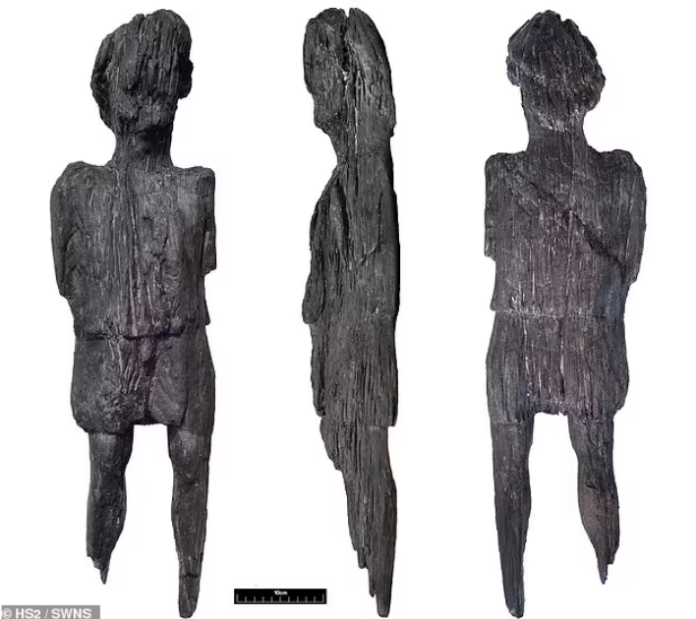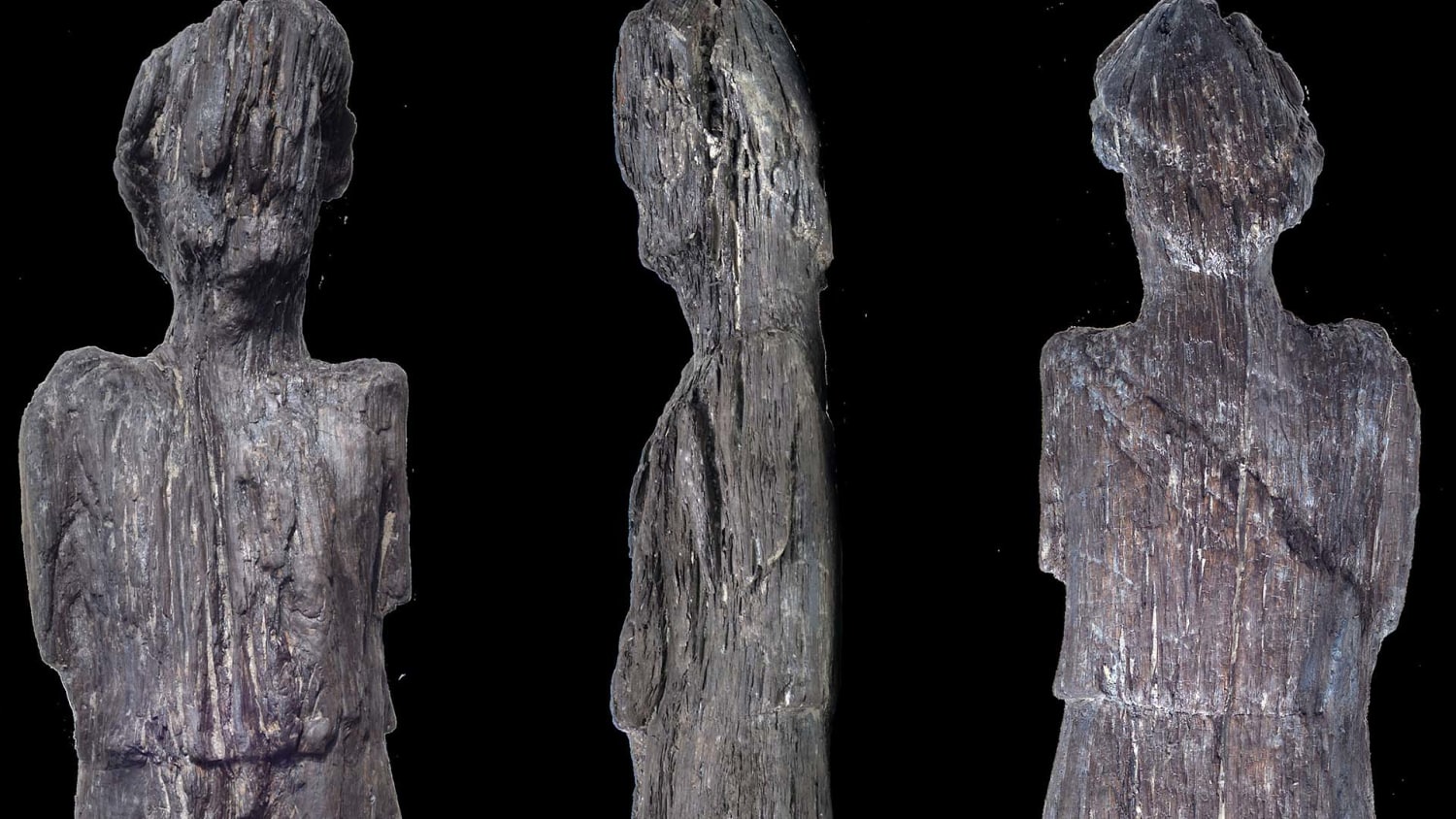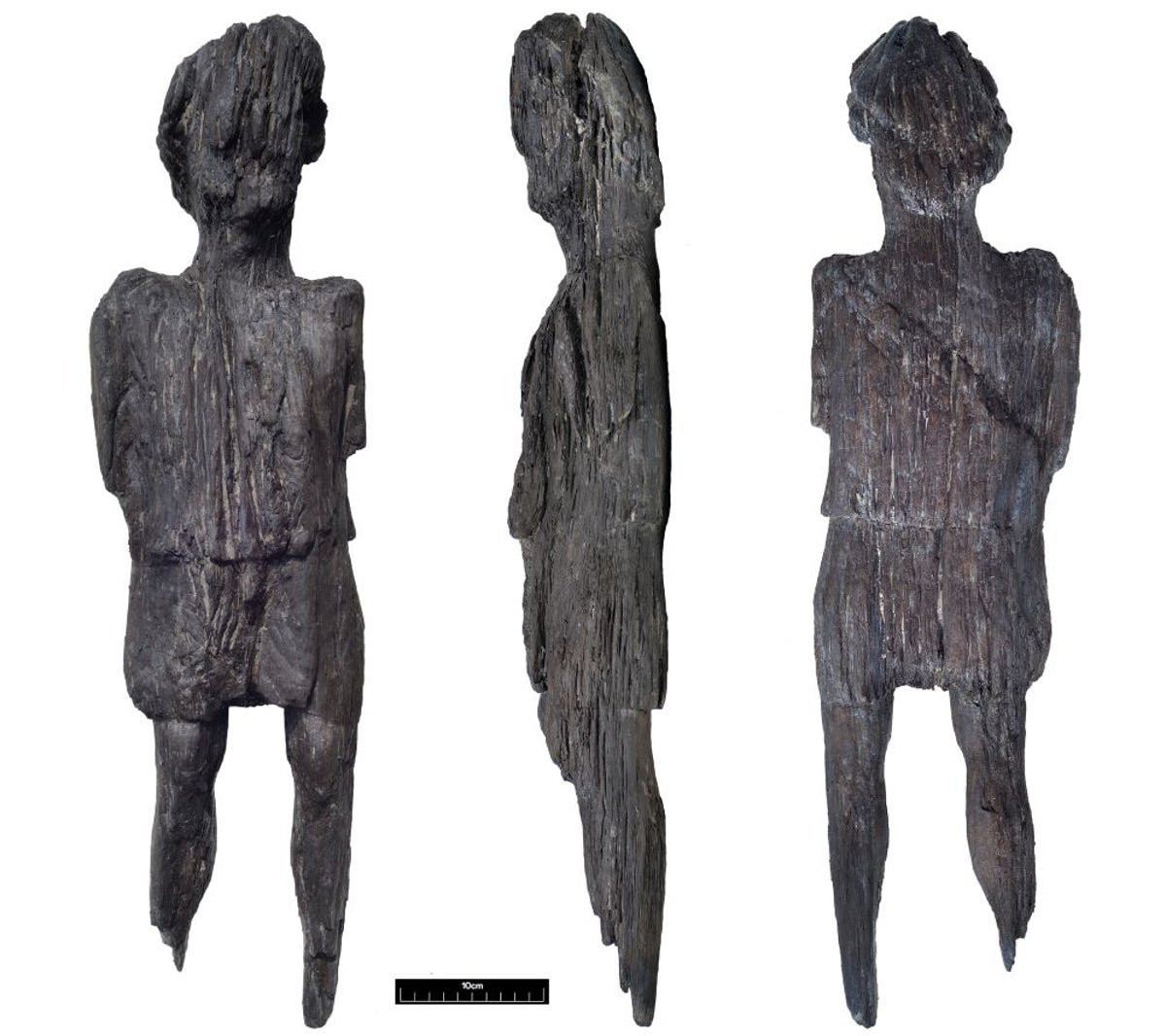Ancient Roman Wooden Figure Unearthed in Buckinghamshire: A Rare Glimpse into 2,000-Year-Old History

In a surprising turn of events, a 2,000-year-old wooden figure has been uncovered in a waterlogged ditch in Buckinghamshire, England. This discovery is especially remarkable due to the rarity of such artifacts surviving from the Roman period in Britain. Found during excavations for the HS2 railway project, this wooden figure offers a unique glimpse into the ancient past, potentially holding religious or cultural significance.
Unearthing a Rare Roman Relic

The wooden figure was discovered in July last year in Twyford, Buckinghamshire, during ongoing work on the HS2 high-speed rail project. Initially dismissed as a mere piece of degraded wood, further analysis revealed that the object was, in fact, a carved human figure. Standing 26 inches (67 cm) tall and 7 inches (18 cm) wide, the figure appears to be dressed in a knee-length tunic tied at the waist and wearing either a hat or sporting a distinctive hairstyle. Although the figure has lost its arms below the elbow and the lower part of its legs, the carving remains an extraordinary find.
Preservation Against the Odds
The survival of this wooden figure for two millennia is attributed to the unique conditions of the ditch where it was found. The lack of oxygen in the waterlogged trench prevented the wood from rotting, preserving the figure in an exceptionally well-preserved state. Archaeologists believe the carving may have been created as a religious offering, potentially for the gods, given its detailed craftsmanship.

Jim Williams, Historic England’s senior science advisor, expressed his amazement at the discovery, stating, “This is a truly remarkable find that brings us face to face with our past. The quality of the carving is exquisite, and the figure is all the more exciting because organic objects from this period rarely survive.”
Radiocarbon Dating and Further Research
To determine the precise age of the figure, researchers plan to conduct radiocarbon dating on a small fragment of the wood that was broken off before the figure was unearthed. This analysis will provide more insights into the figure’s origins and its significance to the people who inhabited Buckinghamshire during the 1st century AD.
The wooden figure was not the only find in the ditch. Archaeologists also recovered shards of pottery dating back to around 43–70 AD, further enriching the historical context of the site. These discoveries raise intriguing questions about the site’s history, such as who the figure represents, its purpose, and why it held significance for the local population.

A Rare and Historical Find
The discovery of this wooden figure is a significant event in British archaeology, as such artifacts from the Roman period are incredibly rare. The last comparable find was the ‘Dagenham Idol,’ a wooden figure dating back to 2250 BC, which was recovered from the Thames in 1922. More recently, in 2019, a Roman-era wooden arm, believed to have been carved as a religious offering, was found at the bottom of a well in Northampton.
The figure is currently undergoing further examination and conservation by experts from York Archaeology. Its story will also be featured on an upcoming episode of BBC Two’s ‘Digging for Britain,’ bringing this remarkable discovery to a broader audience.
Conclusion
The unearthing of this wooden Roman figure in Buckinghamshire is a testament to the rich and often hidden history beneath our feet. As researchers continue to study the figure, it will undoubtedly offer new insights into the religious and cultural practices of ancient Britain. This extraordinary find not only sheds light on the past but also highlights the importance of archaeological preservation in understanding our shared heritage.
Video
News
The Hanging Temple: China’s 1,500-Year-Old Cliffside Marvel of Faith and Engineering
The Hanging Temple: China’s 1,500-Year-Old Cliffside Marvel of Faith and Engineering Perched precariously on the cliffs of Mount Heng in Shanxi Province, China, the Hanging Temple, also known as Xuankong Temple, Hengshan Hanging Temple, or Hanging Monastery, is an architectural…
The Willendorf Venus: A 30,000-Year-Old Masterpiece Reveals Astonishing Secrets
The Willendorf Venus: A 30,000-Year-Old Masterpiece Reveals Astonishing Secrets The “Willendorf Venus” stands as one of the most revered archaeological treasures from the Upper Paleolithic era. Discovered in 1908 by scientist Johann Veran near Willendorf, Austria, this small yet profound…
Unveiling the Maya: Hallucinogens and Rituals Beneath the Yucatán Ball Courts
Unveiling the Maya: Hallucinogens and Rituals Beneath the Yucatán Ball Courts New archaeological research has uncovered intriguing insights into the ritual practices of the ancient Maya civilization. The focus of this study is a ceremonial offering found beneath the sediment…
Uncovering the Oldest Agricultural Machine: The Threshing Sledge’s Neolithic Origins
Uncovering the Oldest Agricultural Machine: The Threshing Sledge’s Neolithic Origins The history of agricultural innovation is a fascinating journey that spans thousands of years, and one of the earliest known agricultural machines is the threshing sledge. Recently, a groundbreaking study…
Nara’s Ancient Sword: A 1,600-Year-Old Protector Against Evil Spirits
Nara’s Ancient Sword: A 1,600-Year-Old Protector Against Evil Spirits In a remarkable discovery that has captured the attention of archaeologists and historians alike, a 7.5-foot-long iron sword was unearthed from a 1,600-year-old burial mound in Nara, Japan. This oversized weapon,…
The Inflatable Plane, Dropped Behind the Lines for Downed Pilots
Experimental The Inflatable Plane, Dropped Behind the Lines for Downed Pilots The Inflatoplane from Goodyear was an unconventional aircraft developed by the Goodyear Aircraft Company, a branch of the renowned Goodyear Tire and Rubber Company, also famed for the Goodyear…
End of content
No more pages to load











